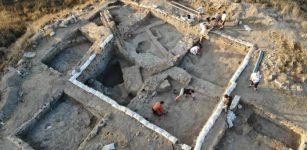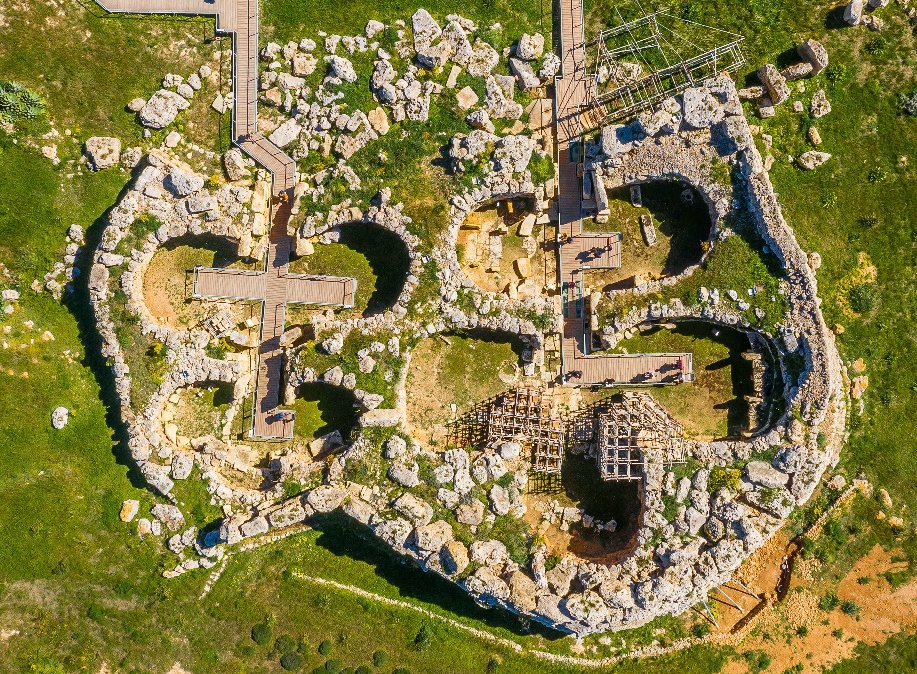Ggantija Double Temple On Malta Is Older Than Stonehenge And Great Pyramid Of Giza
A. Sutherland - AncientPages.com - Early Maltese temples were egg-shaped and resembled the womb of the goddess of fertility.
Later, from 4,000 to 3,000 BC, the Maltese built such temples with four or five semicircular projections off the temple's main room that served different religious purposes.
Down view of Ggantija Gozo. Image credit: Adobe Stock - Sandro
These shapes were intentionally created, giving an impression of the goddess' body. The Neolithic Maltese expressed their religious beliefs by creating many megalithic temple complexes like Ggantija, Mnajdra, Hagar Qim, and Tarxien.
The same prehistoric builders constructed the impressive Hal Saflieni Hypogeum, containing several levels and chambers.
Double Temple Is Dedicated To The Goddess Of Fertility
On Gozo, the second-largest Maltese island, there is a structure known as the Ggantija DoubleTemple. It dates back to around 3,000-3,600 BC and is dedicated to the goddess of fertility.
The Neolithic Maltese people built these gigantic megalithic structures of the hard Coralline Limestone and softer Globigerina Limestone found on the island. These limestone blocks weighed up to fifty tons.
The slabs weighing up to fifty tons give us an idea about the temple builders' incredible engineering and construction skills.
Temple of Ggantija. Image credit: Kritzolina - CC BY-SA 4.0
Ggantija (Ġgant - means' giant' in Maltese) double temple is an impressive structure. It is also known as the Twin Temple. A massive limestone block wall, which places us up to six meters high, encircles both temples.
Legendary Female Giant Sunsuna, The Builder
The ancient legend says that a female giant named "Sunsuna" built the temple walls. It took her only one day and one night, and she did it while nursing a baby. Another version of the legend suggests that "Sunsuna" carried the rocks on her head from a dolmen, Ta' Cenc, located on the south coast of Gozo Island.
The Great Sunsuna Goddess was worshiped as the center of the religion, considered very old and perhaps the oldest religion of humankind. Massive, elaborate temples were built in honor of this goddess.
The remains of these prehistoric structures are still dotting the fascinating landscape of Malta.
Temple of Ggantija. Image credit: BoneA - CC BY-SA 4.0
To build the Temple of Ggantija, the builders used several huge stone blocks. The doorway slabs have round holes that resemble offering holes found in the floors. Archaeologists discovered several stone spheres, suggesting that they may have been used for moving (perhaps manipulating or supporting) the huge megaliths.
Today, there are many theories about how the stone-age people could move gigantic megaliths with only primitive tools.
Ggantija Double Temple of Malta was where many different rituals took place in the main rooms' apses (curving spaces). Worshipers who honored death and regeneration used a lot of stone furniture. The people's customs, who created the temples and later disappeared around 2500 BC, are not well-known and remain obscure.
According to studies, the Temple people did not suffer from diseases, invasions, or lack of food. Still, one theory suggests that religious extremism and environmental conditions somehow caused the end of the religious traditions of these people.
The temple contained, for example, a significant ritual basin approx. one meter across and a pillar carved in low relief depicting a snake; there was also a shrine with three altar tables and a trapezoid-formed slab set on edge. The shrine held several limestone blocks decorated with spirals.
Ggantija Temple. Image credit: Hamelin de Guettelet - CC BY-SA 3.0
Now, there is evidence that the first people to inhabit Malta arrived 700 years earlier than history books indicate. Researchers analyzed ancient soils and DNA and could reveal that Malta’s first inhabitants came from different parts of the Mediterranean and Europe, including Africa.
Researchers also found that a second colonization arrived in 3850 BC from Sicily and lasted an extraordinary 1,500 years in Malta without a break.
However, in some periods of Malta's prehistory, “climate change fluctuations made Malta uninhabitable", according to Professor Caroline Malone, from the Queen's University Belfast have been working at one burial site in Malta since 1987. One of the team's discoveries was in the form of 220,000 bones, representing between 500 and 800 people dating from 3600-2350 BC.
As the settlers in Malta depended on climate change, "there was a substantial break of around 1,000 years between the first settlers and the next group who settled permanently on the Maltese islands and eventually built the megalithic temples."
Carbon dating determined that the Maltese temples were constructed around .3600 BC. Some evidence indicates that several underground temples, similar to that of Hypogeum, might have yet to be uncovered in Malta.
Written by – A. Sutherland - AncientPages.com Senior Staff Writer
Copyright © AncientPages.com All rights reserved. This material may not be published, broadcast, rewritten or redistributed in whole or part without the express written permission of AncientPages.com
Expand for referencesBetsy Ross-Edison, Seven Temples on Malta
Francis Aloisio, The Islands of Dream Speak
More From Ancient Pages
-
 Forseti: Norse God Of Justice And Lawmaker Who Lived In A Shining House
Featured Stories | May 1, 2016
Forseti: Norse God Of Justice And Lawmaker Who Lived In A Shining House
Featured Stories | May 1, 2016 -
 First Humans Appeared In Europe 1.4 Million Years Ago – Stone Tools Found At Korolevo Reveal
Human Beginnings | Mar 8, 2024
First Humans Appeared In Europe 1.4 Million Years Ago – Stone Tools Found At Korolevo Reveal
Human Beginnings | Mar 8, 2024 -
 Ivan The Terrible: Military Arsenal Unearthed Near Moscow
Archaeology | Jan 2, 2016
Ivan The Terrible: Military Arsenal Unearthed Near Moscow
Archaeology | Jan 2, 2016 -
 Ravana: Ten-Headed And Multi-Armed Demon King Of Lanka And Chief Antagonist In Epic Ramayana
Featured Stories | Oct 8, 2019
Ravana: Ten-Headed And Multi-Armed Demon King Of Lanka And Chief Antagonist In Epic Ramayana
Featured Stories | Oct 8, 2019 -
 Cheomseongdae “Star-Gazing Tower” Is The Oldest Observatory In East Asia
Featured Stories | Mar 31, 2021
Cheomseongdae “Star-Gazing Tower” Is The Oldest Observatory In East Asia
Featured Stories | Mar 31, 2021 -
 Death Of Norse God Balder And Loki’s Mischief That Led To Destruction In Ragnarok
Featured Stories | Nov 15, 2016
Death Of Norse God Balder And Loki’s Mischief That Led To Destruction In Ragnarok
Featured Stories | Nov 15, 2016 -
 Numa Pompilius – Remarkable Legendary Second King Of Ancient Rome Who Succeeded Romulus – Did He Ever Exist?
Featured Stories | Mar 2, 2018
Numa Pompilius – Remarkable Legendary Second King Of Ancient Rome Who Succeeded Romulus – Did He Ever Exist?
Featured Stories | Mar 2, 2018 -
 Patara -‘The Chosen City’ Of Ancient Lycia
Civilizations | Sep 15, 2015
Patara -‘The Chosen City’ Of Ancient Lycia
Civilizations | Sep 15, 2015 -
 What Is Pax Sinica?
Ancient History Facts | Apr 26, 2018
What Is Pax Sinica?
Ancient History Facts | Apr 26, 2018 -
 Neith – Fearsome Egyptian Mother Of The Gods – Creator Of Sun God Ra, His Archenemy Serpent God Apophis And The Universe
Egyptian Mythology | Jul 9, 2018
Neith – Fearsome Egyptian Mother Of The Gods – Creator Of Sun God Ra, His Archenemy Serpent God Apophis And The Universe
Egyptian Mythology | Jul 9, 2018 -
 Huge Defensive Wall Excavated At Tel Erani, Israel Is More Than 5,300 Years Old
Archaeology | Sep 12, 2019
Huge Defensive Wall Excavated At Tel Erani, Israel Is More Than 5,300 Years Old
Archaeology | Sep 12, 2019 -
 Mysterious And Sacred Intihuatana Stone Of The Inca Was More Than Just An Astronomy Calendar
Archaeoastronomy | May 8, 2018
Mysterious And Sacred Intihuatana Stone Of The Inca Was More Than Just An Astronomy Calendar
Archaeoastronomy | May 8, 2018 -
 Fossilized Remains Of A Gigantic Jurassic Pterosaur Unearthed In Oxfordshire, UK
Fossils | Jun 5, 2024
Fossilized Remains Of A Gigantic Jurassic Pterosaur Unearthed In Oxfordshire, UK
Fossils | Jun 5, 2024 -
 Ancient Mystery Of Italy’s Long-Lost Civilization That Pre-Dates The Ancient Roman Empire And Other Great Old Cultures
Ancient Mysteries | Mar 29, 2019
Ancient Mystery Of Italy’s Long-Lost Civilization That Pre-Dates The Ancient Roman Empire And Other Great Old Cultures
Ancient Mysteries | Mar 29, 2019 -
 Stunning Discovery Of 1,000-Year-Old Knight’s Sword From Reign Of Poland’s First King Bolesław The Brave
Archaeology | Jul 28, 2022
Stunning Discovery Of 1,000-Year-Old Knight’s Sword From Reign Of Poland’s First King Bolesław The Brave
Archaeology | Jul 28, 2022 -
 Ancient European Buildings Form A Sacred Symbol When Viewed From The Air – Scientist Reveals
Ancient Mysteries | Jun 15, 2018
Ancient European Buildings Form A Sacred Symbol When Viewed From The Air – Scientist Reveals
Ancient Mysteries | Jun 15, 2018 -
 On This Day In History: The Battle Of Benevento Was Fought – On February 26, 1266
News | Feb 26, 2017
On This Day In History: The Battle Of Benevento Was Fought – On February 26, 1266
News | Feb 26, 2017 -
 Danger Lurking In The Woods – Unknown Force And Mysterious Lights – Part 1
Featured Stories | Jul 6, 2018
Danger Lurking In The Woods – Unknown Force And Mysterious Lights – Part 1
Featured Stories | Jul 6, 2018 -
 Completely Intact 2,000-Year-Old ‘Chocolatier Style’ Pot Discovered In Mexican Cave
Archaeology | Jul 30, 2022
Completely Intact 2,000-Year-Old ‘Chocolatier Style’ Pot Discovered In Mexican Cave
Archaeology | Jul 30, 2022 -
 Unique discovery of unknown inscription may change the history of scripts as we know it.
News | Aug 23, 2015
Unique discovery of unknown inscription may change the history of scripts as we know it.
News | Aug 23, 2015




